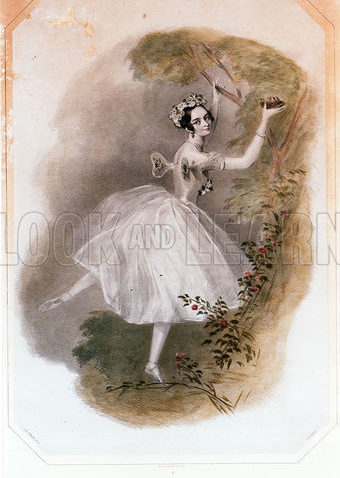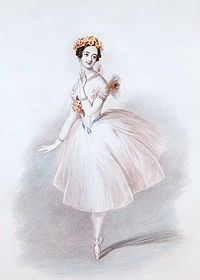Ballet of the past
The ballet “La Sylphide” (not to be confused with the ballet “Les Sylphides”) is an old Romantic warhorse. It’s one of the oldest ballets—maybe even the oldest ballet—for which we still have the choreography and which is still performed with some frequency.
Romantic tales often feature imaginary creatures like woodland nymphs (the sylphide of the title). And they usually don’t end in a finale resembling a Gilbert and Sullivan operetta, with everybody happy and everything resolved. Au contraire.
“La Sylphide” was a role originated by the Italian ballerina Marie Taglioni in 1832, but the choreography that has survived is from 1836. Here are some old artistic renditions of Taglioni in the role. You can see that the impression given was of being weightless, almost flying. In fact, some of the pictures of Taglioni I’ve seen in the past show her flying, which I think wasn’t just an exaggeration of the illusion she accomplished through her dancing skill, but through the use of actual stage machinery. And the sylph has wings, after all—little gossamer wings on her back—and so she is supposed to make us think she certainly could fly if she wanted to do so.
Here’s Taglioni:
“La Sylphide” is definitely a dance from the distant past of ballet. Compared to that, the video I’m about to show is almost recent. It’s from 1962, however, so we can safely say it’s from the past, too, although a not-so-distant past that even I can remember. It features Erik Bruhn and Carla Fracci (also an Italian dancer, like Taglioni), a pair I was lucky enough to see dance many times in person, including in this particular ballet. It was magical in person; but all ballets are so much better in person that it seems a shame to rely on videos.
But video is all we have (this one was from a TV show, which is usually far from ideal). Bruhn died many years ago, and Fracci is now a still-lovely 81 years old. The video is a little funky—a bit blurry, and at one point it turns black-and-white for a short while.
But please watch it; you’ll never see anything with this ethereal quality in dance today. In fact, it was rare even for its time. Fracci captures the spirit of the Romantic ballet perfectly. How does she achieve such incredible lightness? I confess that I don’t know; she wasn’t confiding in me. But I think it was because that was her overriding goal—not to show off her technique, but to hide it in illusion. “Light as air” is a cliché, but here you will see Fracci achieve the closest thing to light-as-air as a human can get. And Bruhn is elegance personified, crisp and musical at all times.
Enjoy:
[NOTE: This post was originally on my older blog and had comments, but unfortunately the comments didn’t transfer over here.]



Comments
Ballet of the past — No Comments
HTML tags allowed in your comment: <a href="" title=""> <abbr title=""> <acronym title=""> <b> <blockquote cite=""> <cite> <code> <del datetime=""> <em> <i> <q cite=""> <s> <strike> <strong>